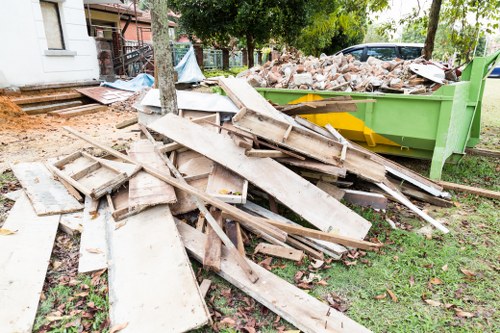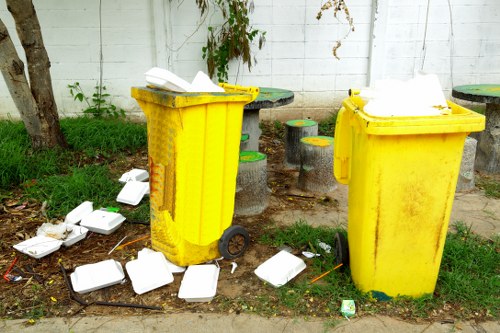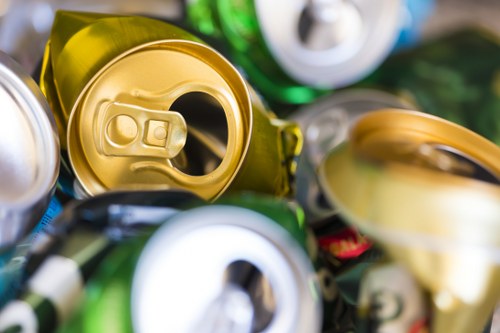Flat Clearance in White Goods Recycle: A Comprehensive Guide
Understanding Flat Clearance

Flat clearance in the context of white goods recycling refers to the process of efficiently removing and disposing of large household appliances such as refrigerators, washing machines, and dishwashers. As technology advances and newer models become available, many homeowners find themselves needing to clear out old white goods that are no longer functional or desired.
Proper flat clearance not only helps in maintaining a clutter-free home but also plays a significant role in environmental conservation. By recycling white goods, valuable materials can be recovered and repurposed, reducing the need for raw material extraction and minimizing waste in landfills.
Engaging in flat clearance ensures that hazardous materials, often found in white goods, are handled safely and responsibly. Components like refrigerants, electronic parts, and metals require specialized disposal methods to prevent environmental contamination.
Benefits of Recycling White Goods

Recycling white goods offers numerous advantages, both for individuals and society as a whole. One of the primary benefits is the conservation of natural resources. By recycling metals such as steel, aluminum, and copper from old appliances, we reduce the demand for mining and processing new raw materials.
Another significant benefit is energy savings. Manufacturing products from recycled materials typically consumes less energy compared to producing them from virgin resources. This reduction in energy usage contributes to lower greenhouse gas emissions, combating climate change.
Furthermore, recycling white goods can lead to economic gains. The recycling industry creates jobs in collection, processing, and manufacturing sectors. It also fosters innovation in developing new recycling technologies and sustainable practices.
Steps Involved in Flat Clearance

The flat clearance process generally involves several key steps to ensure that white goods are disposed of responsibly:
- Assessment: Determine which appliances need to be cleared and assess their condition.
- Scheduling: Arrange a convenient time for the clearance service, ensuring that all appliances can be transported safely.
- Removal: Carefully remove the appliances from the premises, taking care not to damage property or the items themselves.
- Transportation: Transport the white goods to recycling facilities where they will be processed.
- Recycling: Sort and process the appliances to recover usable materials and dispose of any hazardous components properly.
Choosing the Right Recycling Service

Selecting a reputable recycling service is crucial for effective flat clearance. Consider the following factors when choosing a provider:
- Certification: Ensure the company holds relevant environmental and recycling certifications, demonstrating their commitment to sustainable practices.
- Experience: An experienced service provider will have the expertise to handle various types of white goods safely and efficiently.
- Cost: Compare pricing structures to find a service that offers competitive rates without compromising on quality.
- Customer Reviews: Read testimonials and reviews to gauge the reliability and customer satisfaction levels of the service provider.
- Flexibility: A flexible service can accommodate your schedule and specific needs, ensuring a hassle-free clearance process.
Environmental Impact of White Goods Recycling

The environmental implications of white goods recycling are profound. By diverting appliances from landfills, we significantly reduce the accumulation of non-biodegradable waste. Recycling also helps in mitigating pollution by preventing the release of harmful substances contained within white goods, such as refrigerants and heavy metals.
Moreover, the recycling process itself can be environmentally friendly when conducted responsibly. Modern recycling facilities employ advanced technologies to maximize material recovery and minimize energy consumption, aligning with global sustainability goals.
Engaging in white goods recycling also promotes a circular economy, where products and materials are continuously reused and repurposed, fostering long-term environmental stewardship.
Cost-Effectiveness of Flat Clearance
While some may view flat clearance as an additional expense, it can actually be cost-effective in the long run. Proper disposal of white goods can prevent potential fines associated with improper waste management. Additionally, recycling often recovers valuable materials that can offset the costs of the service.
Many recycling services offer competitive pricing, and some may even provide incentives or discounts for bulk clearance. By choosing a professional recycling service, you ensure that the process is efficient and minimizes any further costs associated with DIY disposal methods.
Furthermore, maintaining a clutter-free home can enhance property value and overall quality of life, providing intangible financial benefits.
Legal Considerations in White Goods Recycling
Recycling white goods is subject to various regulations aimed at protecting the environment and public health. It is essential to comply with local and national laws governing the disposal of large appliances and hazardous materials.
Failure to adhere to these regulations can result in hefty fines and legal repercussions. By partnering with a certified recycling service, you ensure that all disposals are handled in accordance with the law, avoiding potential penalties.
Additionally, proper documentation and certification can provide proof of compliance, which is particularly important for businesses involved in white goods recycling.
Innovations in White Goods Recycling
Advancements in recycling technology have significantly improved the efficiency and effectiveness of white goods recycling. Innovations such as automated sorting systems and improved material recovery techniques have increased the volume of materials that can be salvaged from old appliances.
Moreover, sustainable design practices are being integrated into the manufacturing of new white goods, making them easier to disassemble and recycle. This proactive approach reduces the environmental footprint of appliances from inception to end-of-life disposal.
Research and development in recycling processes continue to drive the industry forward, ensuring that white goods recycling remains a viable and sustainable practice.
Challenges in White Goods Recycling
Despite the benefits, white goods recycling faces several challenges. One significant issue is the complexity of modern appliances, which are often composed of various materials glued or welded together, making disassembly difficult.
Additionally, the presence of hazardous materials requires specialized handling, increasing the cost and complexity of the recycling process. Ensuring the safety of workers and the environment necessitates stringent protocols and advanced technology.
Another challenge is consumer awareness. Many individuals are unaware of the importance and methods of recycling white goods, leading to suboptimal disposal practices. Increasing public education and providing accessible recycling services are essential to overcoming this hurdle.
Future Trends in White Goods Recycling
The future of white goods recycling looks promising, with several trends shaping the industry's trajectory:
- Enhanced Automation: Increased automation in recycling facilities will streamline the disassembly and sorting processes, boosting efficiency and reducing labor costs.
- Eco-Friendly Designs: Manufacturers are likely to incorporate more recyclable materials and modular designs in appliances, simplifying the recycling process.
- Policy Support: Governments may implement stricter regulations and provide incentives to encourage white goods recycling, promoting sustainable practices.
- Consumer Engagement: Greater emphasis on educating consumers about the benefits of recycling and providing convenient disposal options.
- Technological Innovations: Continued advancements in recycling technologies will enhance material recovery rates and reduce environmental impacts.
These trends will collectively contribute to a more sustainable and efficient white goods recycling ecosystem.
How to Prepare for Flat Clearance
Preparing for flat clearance ensures a smooth and efficient process. Here are some steps to help you get ready:
- Inventory Assessment: Make a list of all white goods you intend to recycle, noting their make, model, and condition.
- Data Backup: For appliances with electronic components, ensure that all personal data is securely backed up and removed.
- Disconnection: Safely disconnect appliances from power sources, water lines, and other connections. This step may require professional assistance.
- Space Allocation: Clear sufficient space for the removal of appliances, facilitating easy access for the clearance team.
- Schedule Coordination: Confirm the clearance date and time with the service provider, ensuring availability on both ends.
Maximizing Material Recovery
To maximize material recovery during white goods recycling, certain practices can be adopted:
- Thorough Sorting: Separate materials based on their type and recyclability, ensuring that each component is processed appropriately.
- Cleaning: Remove any residual contents or contaminants from appliances to prevent contamination of recyclable materials.
- Disassembly: Carefully disassemble appliances to separate different materials, enhancing the efficiency of the recycling process.
- Quality Control: Implementing quality control measures to ensure that recycled materials meet industry standards for reuse.
By adopting these practices, the recycling process becomes more effective, leading to higher rates of material recovery and reduced environmental impact.
Cost Considerations and Savings
Understanding the cost aspects of flat clearance can help in making informed decisions. Factors influencing costs include the volume and type of white goods, the complexity of disposal, and the service provider's pricing structure.
However, investing in professional clearance services often leads to long-term savings. Proper recycling can reduce the need for purchasing additional storage solutions and prevent potential fines associated with improper disposal.
Additionally, by recovering valuable materials from recycled appliances, the overall cost burden is mitigated, making white goods recycling a financially viable option.
Promoting Sustainability Through Recycling
White goods recycling is a vital component of broader sustainability efforts. By responsibly disposing of large appliances, individuals contribute to the reduction of waste and conservation of natural resources.
Moreover, promoting recycling practices encourages a shift towards more environmentally conscious consumer behavior. This cultural change is essential for achieving long-term sustainability goals and fostering a harmonious relationship with the planet.
Engaging in white goods recycling not only benefits the environment but also sets a positive example for future generations, illustrating the importance of sustainable living.
Final Thoughts on Flat Clearance
Flat clearance in white goods recycling is more than just a logistical task; it is a responsible step towards environmental stewardship and sustainable living. By understanding the benefits, adhering to best practices, and choosing the right service providers, individuals can effectively manage the disposal of large appliances.
Embracing white goods recycling supports the circular economy, conserves valuable resources, and minimizes environmental impact. As the demand for sustainable solutions grows, flat clearance will continue to play a critical role in shaping a greener future.
Ready to clear out your old appliances responsibly? Contact us today to book your flat clearance service and contribute to a sustainable environment.